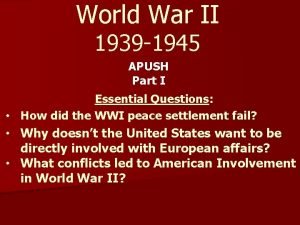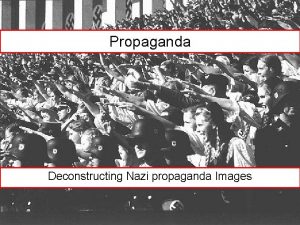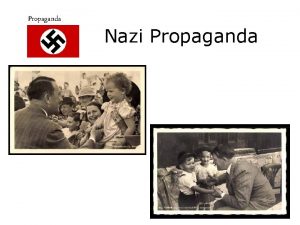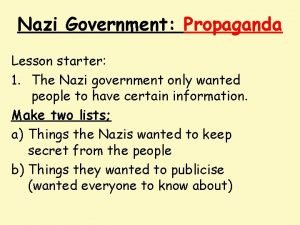Nazi Propaganda What is Propaganda n n Any















- Slides: 15

Nazi Propaganda

What is Propaganda? n n Any media (art, photos, TV, songs, movies, etc) that is used to persuade or manipulate people to believe a particular viewpoint or to behave a certain way Based on the above definition, can you give 3 examples of some propaganda that you have been exposed to? Write your answers and submit them for a classwork grade

What is propaganda? n n Propaganda is commonly used in politics, advertising, and business. To the right is political propaganda protesting the war in Iraq. How does it make you feel? How does this image create emotion in the viewer?

Propaganda & the Nazis The Nazis were masters of political propaganda n They used film, posters, speeches, and radio programs to convince millions of people about their ideas n Nazi propaganda was always big, bright, colorful, and exciting. n The Nazi knew how to use human emotions and senses to manipulate them. n

The Propaganda Poster The cheapest and most widespread propaganda tool was posters n Posters could be hung everywhere, were cheap and quick to produce, and carried a huge conscious and subconscious impact on viewers n The following slides are real examples of these posters. What message do each convey to the viewer? n

The 9 Principles of Nazi Propaganda (taken from Mein Kampf) n n n n n 1. Tell a BIG Lie: always tell a big lie over a small one. The people will believe it more readily 2. Keep It Focused: use only 1 (at most 2) selling points 3. Repetition: use it over and over until even your enemies know them by heart 4. Blame the “other guy”: Never waver, acknowledge doubt, ALWAYS BLAME…never credit…the other side 5. Provoke: first attract attention, then appeal to emotion 6. Create a Crisis: shades of gray don’t work. The issues must be black and white (love/hate, good/evil, life/death, etc) 7. Use Emotional Symbols: good slogans don’t require a literal meaning, just strong emotional appeal. 8. Pander to the lowest common denominator: ignore intellectuals & reasonable arguments. Target the unthinking masses with powerful emotional pitches. 9. There are no Limits: Ignore all moral limits when you believe the stakes are high

Directions: n 1. 2. 3. 4. Answer the following questions for EACH of the images that follow: What do you see in the image? What is the purpose of the propaganda? (for example what ideas, groups, or individuals are promoted by the propaganda? What ideas, groups, or individuals are being attacked? ) What evidence do you see to support your answer to question 2? What emotions do you think the propaganda was designed to create? The Challenge: Propaganda posters were meant to be viewed quickly while walking past them, so they really had to make an impact. You will only be given 10 seconds to view each poster (with some additional time to write your answers).








n HOMEWORK 1. Go to www. mrwoolseyglobal. weebly. com and download this presentation. 2. Reread the 9 Principles of Propaganda. 3. Find any 3 pieces of current propaganda and explain how it meets any of the Principles. Also answer the following questions: A) Has your opinion changed about what you see, read, and hear on TV, radio, books, newspapers, school? Why/Why not? B) Given what you now know about propaganda, how will you make decisions about what you are told by the government or businesses? 4. Type your responses and be sure to include images of the propaganda that you are analyzing. “If you don’t stand for something, you’ll fall for anything”





























